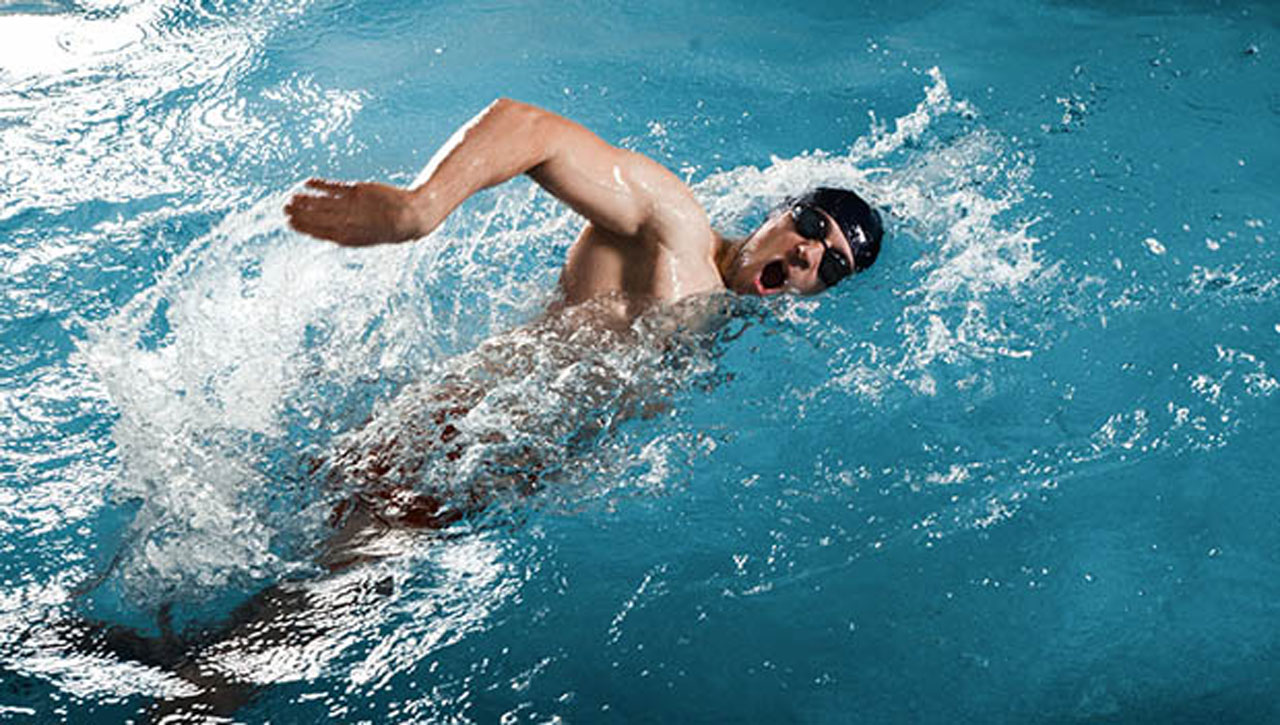
In a country blessed with warm weather, there is no excuse for not getting in a pool (we’ll excuse all you weave-on carriers). With countless benefits, it’s one of the best forms of exercise out there when done right. Find a club with a pool, go to a hotel pool, make a friend with a pool, build one if you have to… just get in one. Here is a list of benefits to squeezing into some speedos (DON’T wear speedos):
Swimming offers something no other aerobic exercise does: the ability to work your body without harsh impact to your skeletal system. When the human body is submerged in water, it automatically becomes lighter. When immersed to the waist, your body bears just 50 percent of its weight; dunk yourself to the chest and that number reduces to around 25 to 35 percent; with water all the way to the neck, you only have to bear 10 percent of your own weight. The pool handles the other 90 percent.
This means that the pool provides an ideal place to work stiff muscles and sore joints, especially if you’re overweight or suffer from arthritis. In its recommendation for the right types of exercise for people with arthritis, the Arthritis Foundation suggests those that stretch muscles, those that strengthen muscles, and those that provide an aerobic workout. A few laps in the pool combine all three! If the pool is heated, so much the better for arthritis sufferers, as the warm water can help loosen stiff joints. In fact, people with rheumatoid arthritis receive greater benefits to their health after participating in hydrotherapy than with other activities. It’s also been proven that water-based exercise improves the use of affected joints and decreases pain from osteoarthritis.
Increased muscle tone and strength
Once you start swimming regularly, it won’t take you long to go from flabby to fit. Ever see a flabby dolphin or a weak-looking competitive swimmer? I didn’t think so. That’s because swimming is a great way to increase muscular strength and muscle tone — especially compared to several other aerobic exercises.
Take running, for example. When a jogger takes a few laps around the track, that jogger is only moving his or her body through air. A swimmer, on the other hand, is propelling himself through water. That means that every kick and every arm stroke becomes a resistance exercise — and it’s well known that resistance exercises are the best way to build muscle tone and strength. There’s yet another bonus: swimming has been shown to improve bone strength — especially in post-menopausal women.
Improved flexibility
Unlike exercise machines in a gym that tend to isolate one body part at a time (like a bicep curl machine, for example), swimming puts the body through a broad range of motion that helps joints and ligaments stay loose and flexible. The arms move in wide arcs, the hips are engaged as the legs scissor through the water, and the head and spine twist from side to side. Plus, with every stroke, as you reach forward, you’re lengthening the body, which not only makes it more efficient in the water, it also helps give you a good stretch from head to toe.
To improve your flexibility beyond the natural gains you’ll make by swimming, you might also want to finish your pool workout with a series of gentle stretches. The support of the water should help you maintain positions involving tricky balance, such as a quadriceps stretch, for longer periods of time.
A healthier heart
In addition to toning visible muscles like pectorals, triceps and quads, swimming also helps improve the most important muscle in our bodies: the heart. Because swimming is an aerobic exercise, it serves to strengthen the heart, not only helping it to become larger, but making it more efficient in pumping, which leads to better blood flow throughout your body. Research also shows that aerobic exercise can combat the body’s inflammatory response as well, a key link in the chain that can lead to heart disease.
If that’s not enough to get you moving in the pool, the American Heart Association reports that just 30 minutes of exercise per day, such as swimming, can reduce the chances of coronary heart disease and lower blood pressure.
Improved asthma symptoms
Unlike exercising in the dry air of the gym, swimming provides the chance to work out in moist air, which can help reduce exercise-induced asthma symptoms. Not only can pool workouts help you avoid asthma attacks if you’re prone to them, some studies have shown that swimming can actually improve the condition overall.
Even those without asthma could benefit from swimming as the exercise can increase lung volume and teach proper breathing techniques.
Weight loss
Swimming is recognized as one of the biggest calorie burners around, and it’s great for keeping weight under control. The exact number of calories you burn, of course, depends on your own physiology and the intensity with which you exercise, but as a general rule, for every 10 minutes of swimming: the breast stroke will burn 60 calories; the backstroke torches 80; the freestyle lights up 100; and the butterfly stroke incinerates an impressive 150.
Continue reading on theguardiannig.wpengine.com/contributors/maje-ayida
[ad unit=2]






